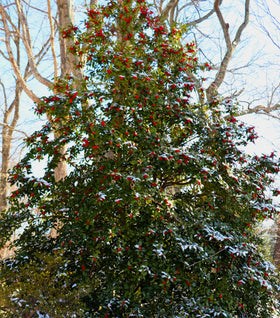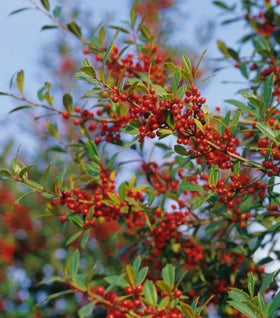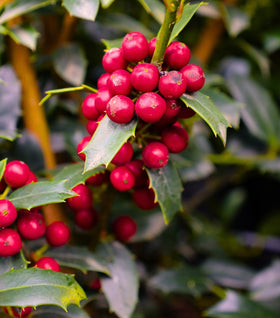Holly Trees
If your landscape is in need of instant structure and four-season curb appeal, holly trees deliver: dense evergreen foliage for privacy, classic winter berries on female selections, and clean, easy-care habits that look polished without constant pruning. We curate landscape-proven hollies—including Nellie R. Stevens, Oak Leaf, American, and Dragon Lady—chosen for vigor, berry set, and strong central leaders.
When you buy holly trees online from Garden Goods Direct, you get nursery-grown, zone-appropriate stock with honest height/spread, clear male/female pollination guidance, and straightforward spacing & planting tips—all backed by our "We Grow Together" Promise. Build a living security fence, flank an entry, or anchor a foundation bed with confidence.
Why Choose Holly Trees: Evergreen Privacy, Holiday Berries & Low-Fuss Care
Hollies bring year-round color and dense screening that outperforms many conifers in tight suburban lots. Female hollies produce red (or orange) berries when a compatible male pollinator is nearby—great for winter décor and songbirds—while glossy foliage stays tidy in heat, wind, and occasional drought once established.
Holly Forms & Foliage That Perform: Pyramids, Columns, and Broad Screens
From upright pyramids, like Nellie R. Stevens, to slim columns, such as Dragon Lady, and broad, oak-leaf textures on Oak Leaf Holly, there’s a silhouette for every space. Expect rich, green leaves that create a luxurious backdrop for hydrangeas, roses, and perennials, plus excellent shearing tolerance for a formal look.
Design That Works: Living Fences, Entry Flankers & Four-Season Foundations
Living Privacy: Stagger pyramidal hollies for faster knit and wind diffusion.
Formal Accents: Use columnar hollies in pairs at gates and garages for an instant touch of architecture.
Foundation Structure: Mix broad hollies with evergreen shrubs and spring bloomers to keep the façade vibrant all year.
Evergreen Security: Hollies have thorny foliage, so when you create a hedge, it generally becomes a true "Green Wall".
Holly Planting & Care Playbook: Sun, Soil, Spacing, and Pollination Tips
Planting: Plant Holly Trees in full sun to part shade with well-drained, slightly acidic soil. Set the root flare at/above grade, water deeply, and mulch 2–3″ (off the trunk). Keep evenly moist the first season; established hollies show good drought tolerance.
Spacing (quick guide): Large pyramids 6–8 ft on center; columns 3–5 ft; broad screens 7–10+ ft.
Pollination: Many popular hollies are dioecious; adding a compatible male nearby can maximize berry set on females.
Complete the composition with shorter Holly Shrubs for layered depth, Deer-Resistant Perennials for low-care color, and Pollinator Plants to support year-round habitat.






